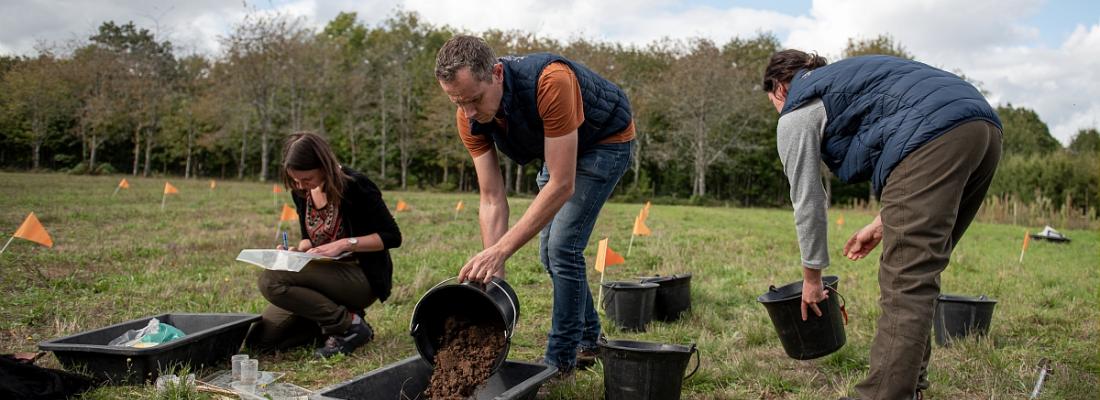Agroecology Reading time 10 min
Soil Quality: towards an indicator system for public policy
Published on 15 January 2025

In France, around 20,000 hectares of natural, agricultural or forest land are artificialized every year.
Gathering indicators to create an indicator system
The study’s authors selected around 50 indicators for monitoring soil quality and health. The indicators apply to a soil function or a type of degradation, and are linked to a reference system for interpretation that specifies the measurement or calculation method used and the reference values (existence values and thresholds) for comparison.
The indicator system also features a series of choices that largely depend on the user’s situation. The system considers the purpose of the assessment (e.g. drafting of a town planning document, agricultural zoning for land consolidation) in selecting the appropriate indicators and choosing the interpretation frame of reference, the monitoring scale (spatial and temporal) and whether or not to aggregate different indicators for the sake of readability.
STUDY DElivErables
The findings from the study “Préserver la qualité des sols : vers un référentiel d’indicateurs” [Soil Quality: towards an indicator system for public policy] are available in three documents:
Cousin I. (coord.), Desrousseaux M. (coord.), Angers D. et al. (2024). Préserver la qualité des sols : vers un référentiel d’indicateurs. Study report, in French, INRAE (France). 780 pages - DOI 10.17180/qnpx-x742 .
Cousin I. (coord.), Desrousseaux M. (coord.), Leenhardt S. (coord.) et al. (2024). Préserver la qualité des sols : vers un référentiel d’indicateurs. Synthesis report, in French, INRAE (France). 126 p. 10.17180/k4j0-m162 - A flipbook version is available HERE
Cousin I., Desrousseaux M. et Leenhardt S. (2024). Soil Quality: towards an indicator system for public policy. Summary in English, INRAE (France), 10 p.
SUMMARY OF THE INRAE STUDY REPORT pdf - 7.20 MBProtecting soil quality: a matter of law
The essential role of soil is not recognized by law, and soil does not enjoy the same protection as air or water. However, “when it comes to the environment, soil quality is essential,” noted Maylis Desrousseaux, one of the study’s two lead scientists. “It’s a goal we’re working towards achieving or restoring,” she added.
Although some legal texts do mention indicators, they are either not specified as such, or only rarely refer to the deterioration of soil functions. Typically, indicators are given as standards relating to soil fertility, non-toxicity or stability, which essentially refer to the end-use quality of soil. Without harmonized standards, decisions are left to the discretion of stakeholders on the ground. This creates disparities across the different areas of France, leading to a need for arbitration at the central government and regional or local authority level. The same happens in the courts, where judges who do not have the necessary objective expertise are often called upon to interpret soil quality in different cases.
Indicators to support ecological soil restoration
When an ecosystem is too degraded, it can benefit from ecological restoration.
According to the Society for Ecological Restoration, “ecological restoration is the process of assisting the recovery of an ecosystem that has been degraded, damaged or destroyed” (SER, 2004).
Soil rehabilitation consists of treatments or activities to restore or improve soil functionality, with the effect of transforming an artificialized soil into a non-artificialized soil (French Climate & Resilience Act, 2021).
The restoration process is monitored and assessed over a long period of time, with a particular focus on ecosystem functions and soil properties. The rehabilitation process requires the chemical, physical and biological parameters of these soils to be monitored and assessed over time to determine changes in the level of ecological functions they perform.
Ris-Orangis: local urban development plans and soil quality
A combination of mapping and field surveys has led the town of Ris-Orangis (near Paris) to establish a “Zero Net Artificialization” strategy. This strategy is included in the town’s urban planning documents and identifies areas to be preserved as well as possible opportunities for ecological restoration and urban densification based on a soil quality analysis.
Local and regional governance of soil quality and health
At what scale would joint governance of soil quality and health be useful?
Current research on the topic covers governance at the local or regional level. In France, this level of governance could be implemented in conjunction with existing bodies or through new coordination bodies capable of managing soil quality and health in an integrated way.
“A comprehensive approach to soil quality must bring all users together to cooperate on the issue,” added Isabelle Cousin, one of the two lead scientists of the study. “The real challenge is for the different stakeholders to agree on what soils are, what they do, what they are worth and what they should be.”
The ways in which soil quality and health are represented, understood, managed and interacted with vary by stakeholder type (i.e. soil users, experts and public decision makers). Even stakeholders in the same category have a range of ideas and priorities based on social determinants and the networks in which norms and values circulate. Stakeholders also view soil quality/health through the lens of their main concerns. “Those working in construction and farmers who rely on irrigation will not be focused on the same quality criteria,” said Adrien Baysse-Lainé, one of the authors of the study. However, an indicator that cuts across several social or political worlds allows these worlds to communicate, while also conveying different meanings.
A STUDY CONDUCTED BY THE DIRECTORATE FOR COLLECTIVE SCIENTIFIC ASSESSMENT, FORESIGHT AND ADVANCED STUDIES (DEPE)
This interdisciplinary study was based on an analysis of the international scientific literature (1,800 references, including 1,500 articles published in peer-reviewed journals). It involved 19 scientific experts in various disciplines (soil science, agronomy, ecology, economics, sociology, law, etc.) from 10 research organizations. The guidelines for collective scientific assessments and advanced studies were applied.
